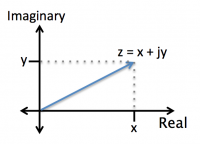Difference between revisions of "Complex Number Review"
From Course Wiki
| Line 1: | Line 1: | ||
{{Template:20.309}} | {{Template:20.309}} | ||
| + | =Overview= | ||
| − | Complex numbers include a real component and an imaginary component, which includes the imaginary number <math>j = \sqrt{-1}</math>. We can represent a complex number like this: <math>z = x + jy</math>, where <math>x</math> is the real part and <math>y</math> is the imaginary part. Complex numbers can be represented on a plot as shown on the right, where the horizontal axis corresponds to the real part and the vertical axis corresponds to the imaginary part. | + | Complex numbers include a real component and an imaginary component, which includes the imaginary number <math>j = \sqrt{-1}</math>. We can represent a complex number like this: <math>z = x + jy</math>, where <math>x</math> is the real part and <math>y</math> is the imaginary part. Complex numbers can be represented on a plot as shown on the right, where the horizontal axis corresponds to the real part and the vertical axis corresponds to the imaginary part. [[Image: ComplexPlane.png|thumb|right|200px]] |
| − | exponential | + | Since we are often dealing with sinusoidal waveforms, it can be helpful to think of complex numbers also in exponential form. According to Euler's identities, |
| + | : <math>e^{j \theta} = cos(\theta) + j sin(\theta)</math> | ||
| + | : <math>cos(\theta) = {e^{j\theta} + e^{-j\theta}\over 2}</math> | ||
| + | : <math>sin(\theta) = {e^{j\theta} - e^{-j\theta}\over 2}</math> | ||
| − | + | =Finding the magnitude= | |
| − | phase | + | =Finding the phase= |
{{Template:20.309 bottom}} | {{Template:20.309 bottom}} | ||
Revision as of 16:55, 11 August 2016
Overview
Complex numbers include a real component and an imaginary component, which includes the imaginary number $ j = \sqrt{-1} $. We can represent a complex number like this: $ z = x + jy $, where $ x $ is the real part and $ y $ is the imaginary part. Complex numbers can be represented on a plot as shown on the right, where the horizontal axis corresponds to the real part and the vertical axis corresponds to the imaginary part.Since we are often dealing with sinusoidal waveforms, it can be helpful to think of complex numbers also in exponential form. According to Euler's identities,
- $ e^{j \theta} = cos(\theta) + j sin(\theta) $
- $ cos(\theta) = {e^{j\theta} + e^{-j\theta}\over 2} $
- $ sin(\theta) = {e^{j\theta} - e^{-j\theta}\over 2} $

